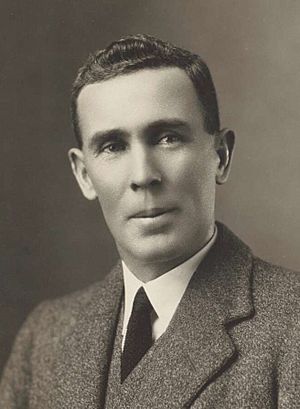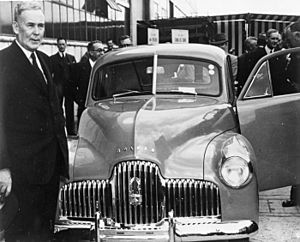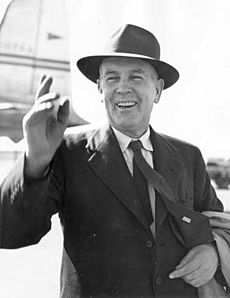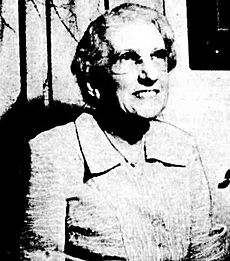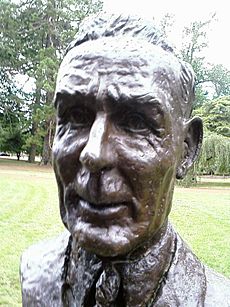Ben Chifley facts for kids
Quick facts for kids
Ben Chifley
|
|
|---|---|
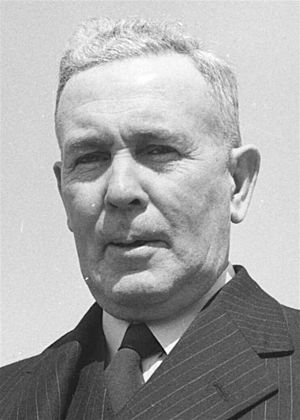
Chifley c. 1948
|
|
| 16th Prime Minister of Australia | |
| In office 13 July 1945 – 19 December 1949 |
|
| Monarch | George VI |
| Governor-General | The Duke of Gloucester Sir William McKell |
| Deputy | Frank Forde H. V. Evatt |
| Preceded by | Frank Forde |
| Succeeded by | Robert Menzies |
| 8th Leader of the Labor Party | |
| In office 13 July 1945 – 13 June 1951 |
|
| Deputy | Frank Forde H. V. Evatt |
| Preceded by | John Curtin |
| Succeeded by | H. V. Evatt |
| Treasurer of Australia | |
| In office 7 October 1941 – 18 December 1949 |
|
| Prime Minister | John Curtin Frank Forde Himself |
| Preceded by | Arthur Fadden |
| Succeeded by | Arthur Fadden |
| 14th Leader of the Opposition | |
| In office 19 December 1949 – 13 June 1951 |
|
| Prime Minister | Robert Menzies |
| Deputy | H. V. Evatt |
| Preceded by | Robert Menzies |
| Succeeded by | H. V. Evatt |
| Minister for Postwar Reconstruction | |
| In office 22 December 1942 – 2 February 1945 |
|
| Prime Minister | John Curtin |
| Preceded by | Office Created |
| Succeeded by | John Dedman |
| Minister for Defence | |
| In office 3 March 1931 – 6 January 1932 |
|
| Prime Minister | James Scullin |
| Preceded by | John Daly |
| Succeeded by | George Pearce |
| Member of the Australian Parliament for Macquarie |
|
| In office 21 September 1940 – 13 June 1951 |
|
| Preceded by | John Lawson |
| Succeeded by | Tony Luchetti |
| In office 17 November 1928 – 19 December 1931 |
|
| Preceded by | Arthur Manning |
| Succeeded by | John Lawson |
| Personal details | |
| Born | 22 September 1885 Bathurst, Colony of New South Wales |
| Died | 13 June 1951 (aged 65) Canberra, Australian Capital Territory, Australia |
| Political party | Labor |
| Other political affiliations |
Industrial Labor (1938–1939) |
| Spouse |
Elizabeth McKenzie
(m. 1917) |
| Education | Limekilns Public School Patrician Brothers' School, Bathurst |
| Occupation | Engine driver (New South Wales Railways) |
Joseph Benedict Chifley (born 22 September 1885 – died 13 June 1951) was an Australian politician. He served as the 16th Prime Minister of Australia from 1945 to 1949. He was also the leader of the Australian Labor Party (ALP) from 1945 until his death in 1951. He became prime minister after John Curtin passed away.
Chifley was born in Bathurst, New South Wales. After school, he worked for the New South Wales Government Railways and became an engine driver. He was very active in the trade union movement before he entered politics. He also helped run a local newspaper called The National Advocate.
After trying several times, Chifley was elected to parliament in 1928. In 1931, he became the Minister for Defence in James Scullin's government. He lost his seat in the 1931 election, when his party suffered a big loss.
After losing his seat, Chifley stayed involved in politics. He supported the federal Labor leaders. In 1935, he worked on a special investigation into the banking system. In 1940, he became a senior public servant in the Department of Munitions. Chifley was re-elected to parliament later that year. He became Treasurer of Australia in the new Curtin Government in 1941. He was one of the few Labor politicians with past experience as a minister. The next year, Chifley also became Minister for Postwar Reconstruction. This made him one of the most powerful people in the government. He became prime minister after Curtin's death in 1945. He won a vote against the temporary prime minister, Frank Forde.
In the 1946 federal election, Chifley was re-elected. This was the first time a Labor government had won re-election while in power. The war ended a month after he became prime minister. Over the next three years, his government started many social reforms and national projects. These included expanding the welfare state and increasing Post-war immigration to Australia. They also set up the Australian National University, the Australian Security Intelligence Organisation (ASIO), and the Snowy Mountains Scheme. Some new laws were challenged in court. As a result, the constitution was changed to give the federal government more power over social services.
Some of Chifley's economic policies were not popular with businesses. This included his plan to take over private banks. His government lost the 1949 federal election. This brought Robert Menzies' Liberal Party into power for the first time. Chifley remained Leader of the Opposition until his death in 1951. Labor did not return to government until 1972. Chifley is often seen as one of Australia's greatest prime ministers. This is because of his work for post-war prosperity. The Labor Party especially remembers his "light on the hill" speech.
Contents
Early Life and Work
Chifley was born in Bathurst, New South Wales, on 22 September 1885. He was the first of three sons. His parents were Roman Catholic. His father was a blacksmith. His mother was from County Fermanagh, in Northern Ireland.
When he was five, Chifley went to live with his grandfather on a farm at Limekilns, New South Wales. His aunt looked after them. Chifley started school at a small local school. It was a "half-time school" because it shared a teacher with another town. He moved back home at 13 after his grandfather died. He then went to a Patrician Brothers school for about two years. He loved to read from a young age. He also took night classes to learn more.
After school, Chifley first worked as a cashier's assistant. He then worked at a tannery. In 1903, he joined the New South Wales Government Railways. He started as a "shop boy" at the Bathurst locomotive shed. Over ten years, he became an engine-cleaner, then a fireman, and finally an engine-driver in 1914. Being a driver was a respected job. Chifley had to pass many tests to become certified. He understood how locomotives worked very well. He also taught at the Bathurst Railway Institute. Chifley drove both goods and passenger trains. He worked mainly on the Main Western railway near Bathurst.
Chifley became involved in the Australian labour movement through the Locomotive Enginemen's Association. He did not hold top positions. Instead, he worked as an organiser. He was known for finding solutions that pleased both railway management and union members. However, Chifley was a local leader in the 1917 Australian general strike. Because of this, he was fired from the railway. He and most other strikers were later hired back. But they lost their seniority and benefits. Chifley was demoted from engine-driver to fireman. Their old benefits were not given back until 1925. After the strike, the state government also removed their union's official status. This made it harder for them to work against other railway unions. Chifley worked to get their union officially recognised again in 1921. He also helped form a national union in 1920.
Early Steps in Politics
Chifley joined the Australian Labor Party when he was young. He helped with state and federal election campaigns. In 1921, he joined the board of The National Advocate. This was a local newspaper that supported the labour movement. In 1922 and 1924, Chifley tried but failed to be chosen as a Labor candidate for the NSW Electoral district of Bathurst. He was finally chosen as the Labor candidate for the Division of Macquarie in the 1925 Australian federal election. Macquarie was a large area with factories, farms, and mines. It was a very close election district. Chifley lost to the current Nationalist politician, Arthur Manning. However, he ran again in 1928. His campaign focused on the government's unpopular labour policies. He won the election, becoming one of three Labor candidates in New South Wales to win seats from the government.
Early Political Career
In the 1929 election, Chifley was re-elected. Labor won by a large amount. James Scullin became the new prime minister. As a new politician with little experience, Chifley did not join Scullin's cabinet. But he did join the Public Accounts Committee. As the Great Depression got worse, he defended the government's economic plans. He stood against critics from within his own party. His loyalty was rewarded in March 1931. The Labor group chose him to fill a spot in the cabinet. Scullin made him Minister for Defence. This job had not been a main focus before. Chifley worked to find ways to save money in his department. This money could then be used to help people who were unemployed. He opened empty military camps for homeless people. He also gave out extra military clothing.
Chifley supported the Premiers' Plan even though he had some doubts. This plan meant cuts to wages and pensions. Many in his local labour movement joined a different Labor group that opposed the plan. His own union even removed him in August 1931. It is said that Joseph Lyons offered Chifley a job as Treasurer if he joined the new United Australia Party. Chifley refused and stayed with the Labor Party. In the 1931 election, Chifley lost his seat in Macquarie. He lost to John Lawson by only 456 votes. The Labor Party ended up with only 14 out of 75 seats in the House of Representatives.
Years Out of Parliament
During the Great Depression, Chifley had no parliamentary salary. He also could not go back to working on the railway. He lived on his wife's family's money and his share of the Bathurst newspaper, The National Advocate.
In 1938, Chifley and other Labor supporters in Bathurst joined the Industrial Labor Party (ILP). This group was formed to challenge the Lang Labor group that controlled the ALP in New South Wales. In 1939, the ILP members rejoined the ALP. Chifley was then elected to the ALP state executive.
In 1935, the Lyons government asked Chifley to be part of the Royal Commission on Banking. He had become an expert on this topic. He wrote a report that suggested private banks should be owned by the government. After trying again in 1934, Chifley finally won his seat back in the 1940 Australian federal election.
Working with John Curtin
Chifley became Treasurer of Australia when John Curtin formed a Labor government in 1941. This happened after the first Menzies government collapsed. Even though Frank Forde was the deputy Labor leader, Chifley became the minister Curtin relied on most. Chifley managed most domestic policies while Curtin focused on World War II. The most important task was funding the war. Another key goal was to control rising prices. In February 1942, Chifley announced that wages and profits would be fixed. He also introduced controls on production and spending. This was to reduce private spending and encourage saving for the war. More price controls were added in April 1942. In July, a single income tax was put in place across Australia.
Historians say Chifley was Australia's greatest Treasurer. He was careful with money. He made sure people understood the need for everyone to share the burden. He also managed the wartime economy well. He funded the war through higher taxes, loans from Australians, and central bank credit. This made sure Australia did not end up with huge overseas debt, like after World War I. Every budget he presented stressed "strong self-control" and saving money. This was to control the large amount of money people had to spend.
Prime Minister
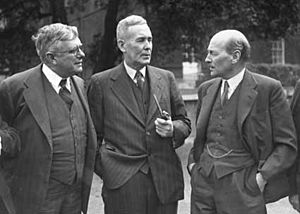

After Curtin died in July 1945, Forde became Prime Minister temporarily. In the leadership vote, Chifley defeated Forde. He became Prime Minister and leader of the ALP. When the war ended in September, normal political life returned. Chifley faced Robert Menzies and his new Liberal Party in the 1946 election. Chifley won this election. This was the first time a federal Labor government had been re-elected for a full term. After the war, Chifley kept wartime economic controls. This included petrol rationing, which was very unpopular. He did this partly to help Britain with its post-war money problems.
When he became prime minister, Chifley also stayed on as Treasurer. He held both roles for his entire time as prime minister. Chifley is the last prime minister to have also been his own Treasurer for such a long time.
What Did Chifley's Government Achieve?
Feeling secure in his position, Chifley worked towards the Labor Party's goal of democratic socialism. This meant the government would play a bigger role in the economy and society. Policies aimed for better working conditions, full employment, and more equal wealth and opportunities. Chifley successfully guided the economy into peacetime. He started many social welfare programs. These included fairer pensions and benefits for unemployment and sickness. His government also built new universities, colleges, and 200,000 houses.
The Chifley government passed a record 299 Acts of Parliament between 1946 and 1949. This was much more than any government before. Among other things, they passed laws to create universal health care. This included free essential medicines. However, this was challenged in the High Court of Australia by doctors' groups. The court ruled it was against the constitution. One of the few successful referendums to change the Australian Constitution happened in 1946. This 1946 Social Services referendum allowed many of the Chifley government's social welfare plans to become law. It gave the federal government more power over health and social services.
For example, in 1946, cheaper radio licenses were introduced for pensioners. This was later extended to other groups and to television licenses. In 1947, rules that stopped certain races from getting benefits were removed. Maternity Allowance payments could be made before the baby was born. Eligibility for child benefits was also expanded. New rules allowed Australians temporarily away from Australia and new migrants to receive benefits. Funeral benefits could also be paid for people who would have qualified for a pension. The Social Services Consolidation Act of 1947 brought together all these benefits. It also made some rules more flexible and increased benefit rates.
Ben Chifley's Government also created the Commonwealth Employment Service. It provided federal money to states for building public housing. The Acoustic Laboratories Act of 1948 set up the Commonwealth Acoustic Laboratories. This was to study hearing loss. Although they could not create a national health service, the Chifley Government improved hospital care. The Mental Institutions Benefits Act of 1948 meant the federal government started funding mental health. The Labor Governments of Chifley and Curtin greatly expanded Australia's social welfare services.
Other achievements included creating a separate Australian citizenship in 1948. They also founded ASIO. Science and education also grew. The Commonwealth Scientific and Industrial Research Organisation (CSIRO) was reorganised and made larger. The Australian National University Act provided advanced study options in Australia. This helped train more university staff. University education greatly benefited from the Australian National University and the Commonwealth Education Office. The Commonwealth Reconstruction Training Scheme helped ex-servicemen go to university. Scholarships were also created to encourage other smart students. Annual grants were given to universities to hire staff and provide housing for the new students. Returned soldiers also received a war bonus, unemployment allowances, loans, and job training.
In July 1948, the Dairy Industry Fund was created to help farmers. More money was given to states to help agriculture grow. Miners also gained a lot from the Coal Industry Tribunal and a Joint Coal Board set up in 1946. Life insurance also became fully regulated.
The Chifley Government's laws included the post-war immigration scheme. They also established Australian citizenship. Construction of the Snowy Mountains Scheme began. Trans Australia Airlines was created, and Qantas was nationalised (meaning it became government-owned). Social services were improved. The Commonwealth Employment Service was created. Federal money was given to states for public housing. A Universities Commission was set up to expand university education. Free hospital treatment was introduced. The CSIRO was reorganised. The Commonwealth Rehabilitation Service was established. One historian said Chifley's government "balanced economic development and welfare support". It provided the basis for Australia's post-war economic success.
Later Challenges
In 1947, Chifley announced the government would take over the banks. This caused huge opposition from the media. Many middle-class people turned against Labor. The High Court found Chifley's law to be against the constitution. The government appealed this decision, but the court's decision was upheld.
However, Chifley's government did pass the Banking Act 1945 and the Commonwealth Bank Act 1945. These laws gave the government control over money policy. They also made the Commonwealth Bank Australia's national bank.
During a railway strike in Queensland in 1948, Chifley stopped striking workers from getting unemployment benefits. A long and difficult strike in the coal industry began in June 1949. This caused unemployment and hardship. Chifley saw the strike as an attempt by the Communist Party to challenge Labor. He sent in 13,000 army troops to end the strike. Early in the strike, Chifley and H. V. Evatt froze the Miner's Federation's money. They also introduced laws to make workers go back to work.
In 1949, Chifley stated that the Labor Party was a "strong defence against communism". He said the best way to weaken the Communist Party was to "improve the conditions of the people". Despite this, Menzies used the growing fear of the Cold War to say Labor was weak on Communism. These events, along with a feeling that Labor had become too proud, led to the Liberal Party winning the 1949 election. While Labor won more seats in the House of Representatives, Menzies and his group won many more. Labor kept control of the Senate, though.
In Opposition
Chifley was now 64 and not in good health. He was a lifelong smoker. But he chose not to retire from politics. Even though he was out of government, Labor still had a majority in the Senate. Chifley remained Labor leader and became Leader of the Opposition. The Labor majority in the Senate often changed or blocked laws proposed by the Menzies Government.
Menzies responded by introducing a bill to ban the Communist Party of Australia in 1950. He expected Chifley to reject it. This would give Menzies a reason to call a special election. Menzies hoped to use the "soft-on-Communism" idea again to win control of both parts of parliament.
However, Chifley allowed the bill to pass after it was changed. (It was later ruled unconstitutional by the High Court). But when Chifley rejected Menzies' Commonwealth Banking Bill a few months later, Menzies called a special election for April 1951. Chifley led Labor to win more seats in the House. But Labor lost seats in the Senate. This gave Menzies' group control of both parts of parliament.
Death
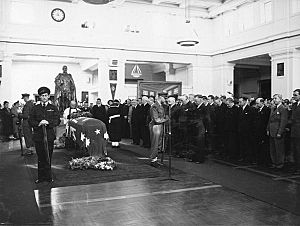
A few weeks later, on 13 June 1951, Chifley had a heart attack. He was in his room at the Hotel Kurrajong in Canberra.
Chifley at first made light of the chest pains. He tried to stop his secretary, Phyllis Donnelly, from calling a doctor. But his condition got worse. Donnelly called Dr. John Holt, who said Chifley needed to go to the hospital right away. Chifley died in an ambulance on the way to the Canberra Community Hospital. He was pronounced dead at 10:45 pm.
Menzies heard about Chifley's death while at a parliamentary dance. Chifley had been invited but had not attended.
Chifley was buried at the Bathurst cemetery on 18 June 1951.
Personal Life
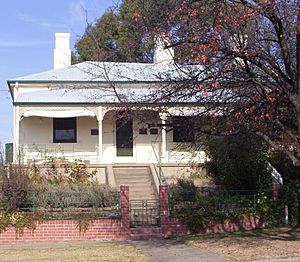
Chifley married Elizabeth McKenzie (known as "Lizzie") on 6 June 1914. She was the daughter of a more senior railway employee. The couple started dating in 1912. They had known each other since childhood. The McKenzies were Presbyterian, and Elizabeth did not want to become Catholic like Chifley. The Catholic Church was against mixed marriages at the time. So, the couple chose to marry in a Presbyterian church in Sydney. Their parents were against the marriage and did not attend. But their families eventually made up. The McKenzies were quite wealthy. Chifley was seen as "marrying into money" for his time.
After their marriage, Chifley's father-in-law gave them a house on Busby Street, Bathurst. They lived there for the rest of their lives. It is now a historic site called "Ben Chifley's House". It has been a house museum since 1973. Chifley and his wife did not have children. She had a serious health problem around 1915. She later developed chronic back pain that made it hard for her to move around. The couple lived mostly separate lives. This was first because of his railway work, and later because of his political career. She rarely left Bathurst and never lived in Canberra, even when he was prime minister. She usually only visited for special events. Her health stopped her from helping with his campaigns. She was also not very interested in politics. However, they seemed to have a close and caring relationship throughout his life. She lived 11 years longer than her husband, dying in 1962.
Legacy and Honours
In 1987, the New South Wales Labor government decided to name a new university in Sydney's western suburbs "Chifley University". There was some debate when a new Liberal government renamed it the University of Western Sydney in 1989. Later, the decision to rename it was supported. This was to link the name of Greater Western Sydney to important institutions.
Many places and institutions are named after Chifley:
- the suburb of Chifley in Canberra
- the suburb of Chifley in Sydney
- the Division of Chifley, a federal election area
- his former house in Bathurst, now a museum
- Chifley Library, the main library at the Australian National University, Canberra
- Chifley Tower and Chifley Square in Sydney
- Chifley Cave, one of the Jenolan Caves in the Blue Mountains
- several public high schools in Western Sydney are now called Chifley College.
- a group of dormitories at Charles Sturt University's Bathurst campus are called Chifley Halls
- Chifley Research Centre, the official think tank of the Australian Labor Party
- Chifley dam near Bathurst.
In 1975, he was honoured on a postage stamp with his picture.
One of the locomotives Chifley drove, 5112, is displayed at the Bathurst railway station. In 1971, Commonwealth Railways named a diesel locomotive Ben Chifley.
See also
 In Spanish: Ben Chifley para niños
In Spanish: Ben Chifley para niños
- Chifley Government
- First Chifley Ministry
- Second Chifley Ministry
- 1949 Australian coal strike
- The light on the hill


